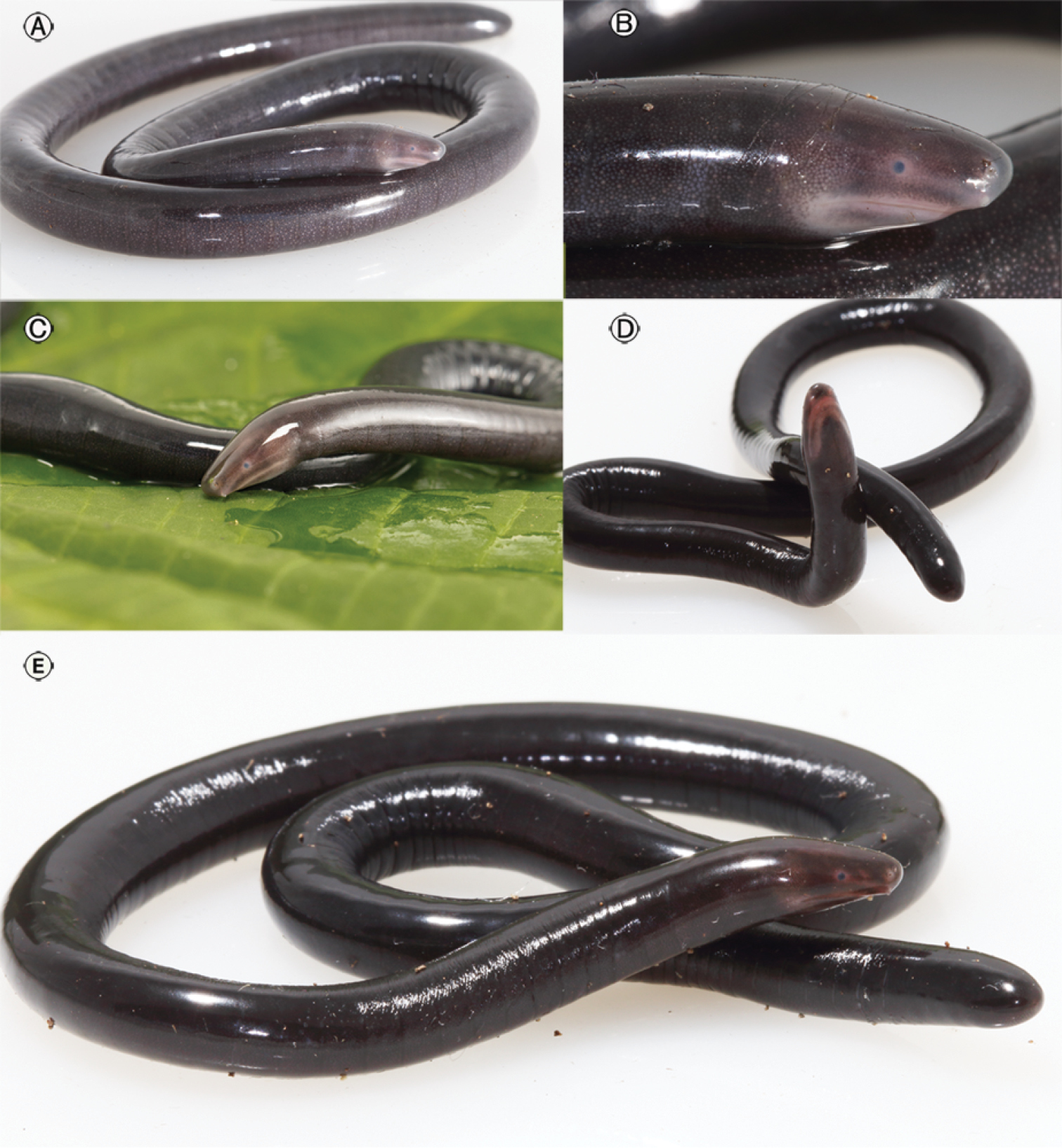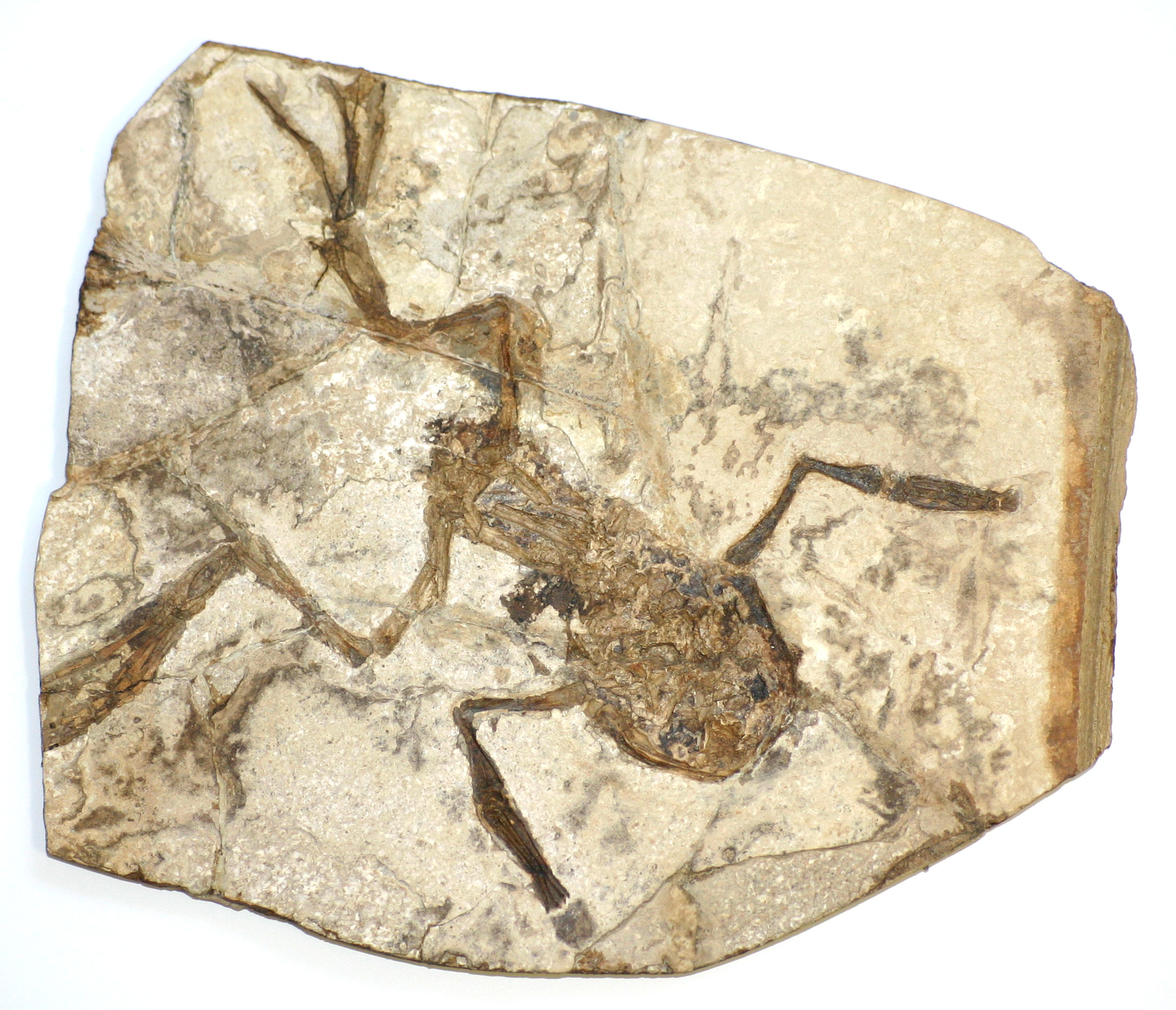|
Lissamphibia
The Lissamphibia (from Greek λισσός (lissós, "smooth") + ἀμφίβια (amphíbia), meaning "smooth amphibians") is a group of tetrapods that includes all modern amphibians. Lissamphibians consist of three living groups: the Salientia (frogs and their extinct relatives), the Caudata (salamanders and their extinct relatives), and the Gymnophiona (the limbless caecilians and their extinct relatives). Salientians and caudatans are likely more closely related to each other than to caecilians. The name Batrachia is commonly used for the clade combining salientians and caudatans. A fourth group, the Allocaudata (also known as Albanerpetontidae) is also known, spanning 160 million years from the Middle Jurassic to the Early Pleistocene, but became extinct two million years ago. For several decades, this name has been used for a group that includes all living amphibians, but excludes all the main groups of Paleozoic tetrapods, such as Temnospondyli, Lepospondyli, Embolome ... [...More Info...] [...Related Items...] OR: [Wikipedia] [Google] [Baidu] |
Temnospondyli
Temnospondyli (from Greek τέμνειν, ''temnein'' 'to cut' and σπόνδυλος, ''spondylos'' 'vertebra') or temnospondyls is a diverse ancient order of small to giant tetrapods—often considered primitive amphibians—that flourished worldwide during the Carboniferous, Permian and Triassic periods, with fossils being found on every continent. A few species continued into the Jurassic and Early Cretaceous periods, but all had gone extinct by the Late Cretaceous. During about 210 million years of evolutionary history, they adapted to a wide range of habitats, including freshwater, terrestrial, and even coastal marine environments. Their life history is well understood, with fossils known from the larval stage, metamorphosis and maturity. Most temnospondyls were semiaquatic, although some were almost fully terrestrial, returning to the water only to breed. These temnospondyls were some of the first vertebrates fully adapted to life on land. Although temnospondyls are amph ... [...More Info...] [...Related Items...] OR: [Wikipedia] [Google] [Baidu] |
Amphibian
Amphibians are ectothermic, anamniote, anamniotic, tetrapod, four-limbed vertebrate animals that constitute the class (biology), class Amphibia. In its broadest sense, it is a paraphyletic group encompassing all Tetrapod, tetrapods, but excluding the amniotes (tetrapods with an amniotic membrane, such as modern reptiles, birds and mammals). All extant taxon, extant (living) amphibians belong to the monophyletic subclass (biology), subclass Lissamphibia, with three living order (biology), orders: Anura (frogs and toads), Urodela (salamanders), and Gymnophiona (caecilians). Evolved to be mostly semiaquatic, amphibians have adapted to inhabit a wide variety of habitats, with most species living in freshwater ecosystem, freshwater, wetland or terrestrial ecosystems (such as riparian woodland, fossorial and even arboreal habitats). Their biological life cycle, life cycle typically starts out as aquatic animal, aquatic larvae with gills known as tadpoles, but some species have devel ... [...More Info...] [...Related Items...] OR: [Wikipedia] [Google] [Baidu] |
Tetrapod
A tetrapod (; from Ancient Greek :wiktionary:τετρα-#Ancient Greek, τετρα- ''(tetra-)'' 'four' and :wiktionary:πούς#Ancient Greek, πούς ''(poús)'' 'foot') is any four-Limb (anatomy), limbed vertebrate animal of the clade Tetrapoda (). Tetrapods include all Neontology#Extant taxa versus extinct taxa, extant and Extinction, extinct amphibians and amniotes, with the latter in turn Evolution, evolving into two major clades, the Sauropsida, sauropsids (reptiles, including dinosaurs and therefore birds) and synapsids (extinct pelycosaur, "pelycosaurs", therapsids and all extant mammals, including Homo sapiens, humans). Hox gene mutations have resulted in some tetrapods becoming Limbless vertebrate, limbless (snakes, legless lizards, and caecilians) or two-limbed (cetaceans, sirenians, Bipedidae, some lizards, kiwi (bird), kiwis, and the extinct moa and elephant birds). Nevertheless, they still qualify as tetrapods through their ancestry, and some retain a pair of ves ... [...More Info...] [...Related Items...] OR: [Wikipedia] [Google] [Baidu] |
Allocaudata
The Albanerpetontidae (also spelled Albanerpetidae and Albanerpetonidae) are an extinct family of small amphibians, native to the Northern Hemisphere during the Mesozoic and Cenozoic. The only members of the order Allocaudata, they are thought to be allied with living amphibians belonging to Lissamphibia. Despite a superficially salamander-like bodyform, their anatomy is strongly divergent from modern amphibians in numerous aspects. The fossil record of albanerpetontids spans over 160 million years from the Middle Jurassic to the beginning of the Pleistocene, about 2.13–2 million years ago. History of research The earliest specimen of an albanerpetontid to be discovered was that of '' Celtedens megacephalus'' from the Early Cretaceous (Albian) Pietraroja Plattenkalk of Italy, described by Oronzio Gabriele Costa in 1864, and originally placed in the genus ''Triton,'' a junior synonym of the salamander genus '' Triturus''. Jaw elements of albanerpetontids from the Cretaceous of ... [...More Info...] [...Related Items...] OR: [Wikipedia] [Google] [Baidu] |
Lepospondyli
Lepospondyli is a diverse clade of early tetrapods. With the exception of one late-surviving lepospondyl from the Late Permian of Morocco ('' Diplocaulus minimus''), lepospondyls lived from the Visean stage of the Early Carboniferous to the Early Permian and were geographically restricted to what is now Europe and North America. Five major groups of lepospondyls are known: Adelospondyli; Aïstopoda; Lysorophia; Microsauria; and Nectridea. Lepospondyls have a diverse range of body forms and include species with newt-like, eel- or snake-like, and lizard-like forms. Various species were aquatic, semiaquatic, or terrestrial. None were large (the biggest genus, the diplocaulid '' Diplocaulus'', reached a meter in length, but most were much smaller), and they are assumed to have lived in specialized ecological niches not taken by the more numerous temnospondyl amphibians that coexisted with them in the Paleozoic. Lepospondyli was named in 1888 by Karl Alfred von Zittel, who coi ... [...More Info...] [...Related Items...] OR: [Wikipedia] [Google] [Baidu] |
Caecilian
Caecilians (; ) are a group of limbless, vermiform (worm-shaped) or serpentine (snake-shaped) amphibians with small or sometimes nonexistent eyes. They mostly live hidden in soil or in streambeds, and this cryptic lifestyle renders caecilians among the least familiar amphibians. Modern caecilians live in the tropics of South America, South and Central America, Africa, and southern Asia. Caecilians feed on small subterranean creatures, such as earthworms. The body is cylindrical and often darkly coloured, and the skull is bullet-shaped and strongly built. Caecilian heads have several unique adaptations, including fused cranial and jaw bones, a two-part system of jaw muscles, and a Chemoreceptor, chemosensory tentacle in front of the eye. The skin is slimy and bears ringlike markings or grooves and may contain scales. Modern caecilians are a clade, the Order (biology), order Gymnophiona (or Apoda ), one of the three living amphibian groups alongside Anura (frogs) and Urodela (sa ... [...More Info...] [...Related Items...] OR: [Wikipedia] [Google] [Baidu] |
Gymnophiona
Caecilians (; ) are a group of limbless, vermiform (worm-shaped) or serpentine (snake-shaped) amphibians with small or sometimes nonexistent eyes. They mostly live hidden in soil or in streambeds, and this cryptic lifestyle renders caecilians among the least familiar amphibians. Modern caecilians live in the tropics of South and Central America, Africa, and southern Asia. Caecilians feed on small subterranean creatures, such as earthworms. The body is cylindrical and often darkly coloured, and the skull is bullet-shaped and strongly built. Caecilian heads have several unique adaptations, including fused cranial and jaw bones, a two-part system of jaw muscles, and a chemosensory tentacle in front of the eye. The skin is slimy and bears ringlike markings or grooves and may contain scales. Modern caecilians are a clade, the order Gymnophiona (or Apoda ), one of the three living amphibian groups alongside Anura (frogs) and Urodela ( salamanders). Gymnophiona is a crown grou ... [...More Info...] [...Related Items...] OR: [Wikipedia] [Google] [Baidu] |
Frog
A frog is any member of a diverse and largely semiaquatic group of short-bodied, tailless amphibian vertebrates composing the order (biology), order Anura (coming from the Ancient Greek , literally 'without tail'). Frog species with rough skin texture due to wart-like parotoid glands tend to be called toads, but the distinction between frogs and toads is informal and purely cosmetic, not from taxonomy (biology), taxonomy or evolutionary history. Frogs are widely distributed, ranging from the tropics to subarctic regions, but the greatest concentration of species diversity is in tropical rainforest and associated wetlands. They account for around 88% of extant amphibian species, and are one of the five most diverse vertebrate orders. The oldest fossil "proto-frog" ''Triadobatrachus'' is known from the Early Triassic of Madagascar (250Myr, million years ago), but molecular clock, molecular clock dating suggests their divergent evolution, divergence from other amphibians may exte ... [...More Info...] [...Related Items...] OR: [Wikipedia] [Google] [Baidu] |
Salientia
The Salientia (Latin ''salire'', ''salio'' meaning "to jump") are a total group of amphibians that includes the order Anura, the frogs and toads, and various extinct proto-frogs that are more closely related to the frogs than they are to the Urodela, the salamanders and newts. The oldest fossil "proto-frog" appeared in the early Triassic of Madagascar, but molecular clock dating suggests their origins may extend further back to the Permian, 265 million years ago. Characteristics Very few fossils of early salientians have been found, which makes defining the characteristics of the group and their taxonomic relationships difficult. The arrangement of pectoral elements and the number of vertebrae are some guides, but the degree of vertebral articulation and the arrangement of the bones in the leg have not been found to be reliable indicators. The early proto-frogs developed from temnospondyl ancestors in which some of the elements of their vertebrae remained separate. The str ... [...More Info...] [...Related Items...] OR: [Wikipedia] [Google] [Baidu] |
Gerobatrachus NT
''Gerobatrachus'' is an extinct genus of amphibamid temnospondyl (represented by the type species ''Gerobatrachus hottoni'') that lived in the Early Permian, approximately 290 million years ago (Ma), in the area that is now Baylor County, Texas. When it was first described in 2008, ''Gerobatrachus'' was announced to be the closest relative of Batrachia, the group that includes modern frogs and salamanders. It possesses a mixture of characteristics from both groups, including a large frog-like head and a salamander-like tail. These features have led to it being dubbed a frogamander by the press. Some more recent studies place ''Gerobatrachus'' as the closest relative of Lissamphibia, the group that contains all modern amphibians including frogs, salamanders, and caecilians, or place modern amphibians far from ''Gerobatrachus'' within a group called Lepospondyli. Description The only known specimen of ''Gerobatrachus'' is a nearly complete skeleton (USNM 489135) about long, that ... [...More Info...] [...Related Items...] OR: [Wikipedia] [Google] [Baidu] |






